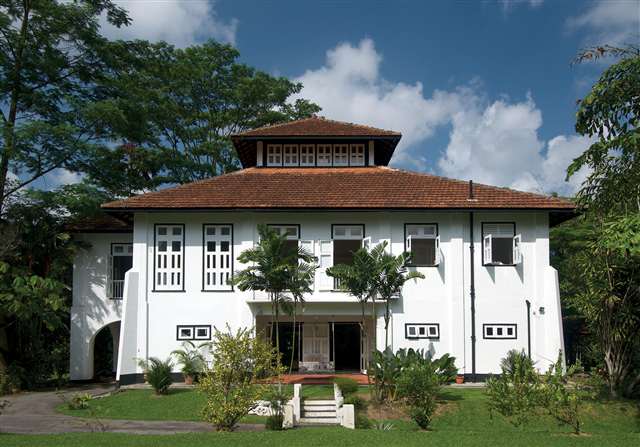*Editor's note at 3.40pm, July 5: We have updated the correct origin of the word "bungalow" in this article, after receiving feedback from a reader.
The old colonial-era bungalow at 38 Oxley Road has been in the news lately, with the Lee siblings publicly squabbling over it.
So, since we're on this topic of bungalows, let's take a look at the beauties in Singapore that are known as black-and-whites.
Ah, black-and-whites – the beautiful colonial bungalows found in the estates of Alexandra, Nassim, and your dreams.
Did you know that the term 'bungalow' is actually derived from the Hindi word bangala which means 'of, or belonging to, Bengal'?
It refers to the time when the British colonial administration in India adapted the local way of building houses, which included features like verandahs and broad eaves.
While the original idea for the houses came from India, the British adapted the template for a bungalow when they came to tropical Malaya.
Black-and-white bungalows get their names from the dark timber beams and whitewashed walls that are usually found in such houses.
1. Black-and-whites are unique to Malaya.
Black-and-white bungalows were originally built by the Public Words Department (PWD) of the British Administration for British expatriates in the early 20th century, and before World War Two, as accommodation for military personnel.
Most of the estimated 500 colonial black-and-whites found today in Singapore were built between 1903-1928. Those that are owned by the Government have been conserved.
 Image via Remember Singapore.
Image via Remember Singapore.
Unfortunately, most of the privately owned houses (which in many cases, were more beautifully constructed compared to the government commissioned ones) have been demolished or sold to private developers as property prices soared over the years.
 Black-and-white house in Seletar. Image via.
Black-and-white house in Seletar. Image via.
2. We can thank Alfred John Bidwell for black-and-whites.
Famed architect Regent Alfred John Bidwell is the man often credited with kickstarting the popularity of black-and-white houses in Singapore.
His black-and-white house for W. Prichitt on Cluny Road is likely to have started the black-and-white trend. Unfortunately, the Prichitt House is no longer standing today.
Working for colonial Singapore's most famous architectural firm, Swan and Maclaren, Bidwell is also the creative brains behind prominent landmarks such as the Raffles Hotel, and the Victoria Memorial Hall.
3. Fusion of cultures.
Named after their characteristic black timber and whitewashed walls, the black-and-whites are a beautiful confluence of English style and tropical sensibilities.
In his book, Black and White, the Singapore House 1898 - 1941, Julian Davison remarked that the black-and-white is 'mock Tudor in a tropical frock', a testament to how the building adapted to tropical weather while retaining the beauty of English homes.
For one, the ground floor is constructed of tiled bricks while the upper floors made of timber. This ensured that the ground floor remains cool throughout the day.
 Image via Pinterest.
Image via Pinterest.
Black-and-white houses also borrowed from the Malay tradition of building on stilts. This ensured that air is circulated underneath the house. It also prevents attacks from termites, and from damage caused by flash floods.
The inclusion of wide, open verandahs also ensured that wind is circulated throughout the house keeping it airy.
[caption id="" align="aligncenter" width="715"] Example of a traditional Malay house. Source: Pinterest[/caption]
Example of a traditional Malay house. Source: Pinterest[/caption]
4. They can still be found across the island
Today, you'll find black-and-whites scattered around the island, in places such as Nassim Road, Seton Close, Chatsworth Park, Goodwood Hill, Alexandra Park, and even the Botanic Gardens.
Unfortunately, the best specimens of black-and-whites were privately commissioned and were sold off or demolished when property prices increased. These private specimens were usually grander in appearance, with more luxurious designs, although they still retained the black-and-white colour theme.
 Image via.
Image via.
Most of the specimens we see today are the works of the colonial government, which tended to border on the more austere, cost-saving side. These houses are more stripped own in appearance. They managed to stay untouched because after independence, the British government handed over these houses to the Singapore government, who then took the step of conserving these precious pieces of heritage.
 Via Pinterest.
Via Pinterest.
5. You can rent one
Okay. So now that you know how 'cool' these houses are, the inevitable questions is: How do I get my hands on one?
Most black-and-whites are state property under the Singapore Land Authority (SLA). To rent one, you'll have to submit a bid via the State Property Information Online (SPIO) and cross your fingers.
 Via Roots.sg
Via Roots.sg
Alternatively, you can try shelling out some dough to rent one from private owners via Property Guru.
According to this 2014 Expat Living piece, rates can range from as low as $3,000 to as high as $25,000 per month. Yikes.
Top photo via Pinterest
1819 is a labour of love by Mothership.sg where we tell stories from Singapore’s history, heritage & culture. Follow us on Facebook, Instagram and Twitter!
If you like what you read, follow us on Facebook, Instagram, Twitter and Telegram to get the latest updates.
